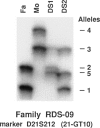Abstract
We used DNA polymorphic markers on the long arm of human chromosome 21 in order to determine the parental and meiotic origin of the extra chromosome 21 in families with recurrent free trisomy 21. A total of 22 families were studied, 13 in which the individuals with trisomy 21 were siblings (category 1), four families in which the individuals with trisomy 21 were second-degree relatives (category 2), and five families in which the individuals with trisomy 21 were third-degree relatives, that is, their parents were siblings (category 3). In five category 1 families, parental mosaicism was detected, while in the remaining eight families, the origin of nondisjunction was maternal. In two of the four families of category 2 the nondisjunctions originated in individuals who were related. In only one of five category 3 families, the nondisjunctions originated in related individuals. These results suggest that parental mosaicism is an important etiologic factor in recurrent free trisomy 21 (5 of 22 families) and that chance alone can explain the recurrent trisomy 21 in many of the remaining families (14 of 22 families). However, in a small number of families (3 of 22), a familial predisposing factor or undetected mosaicism cannot be excluded.
Full text
PDF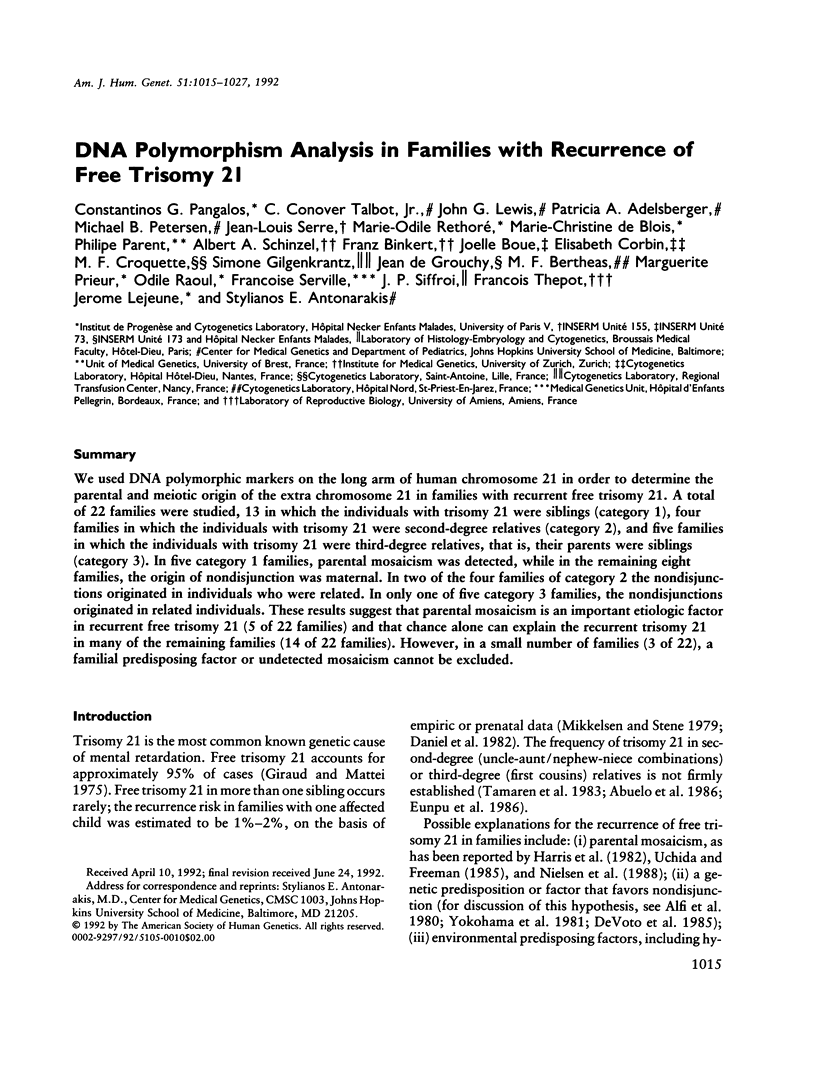
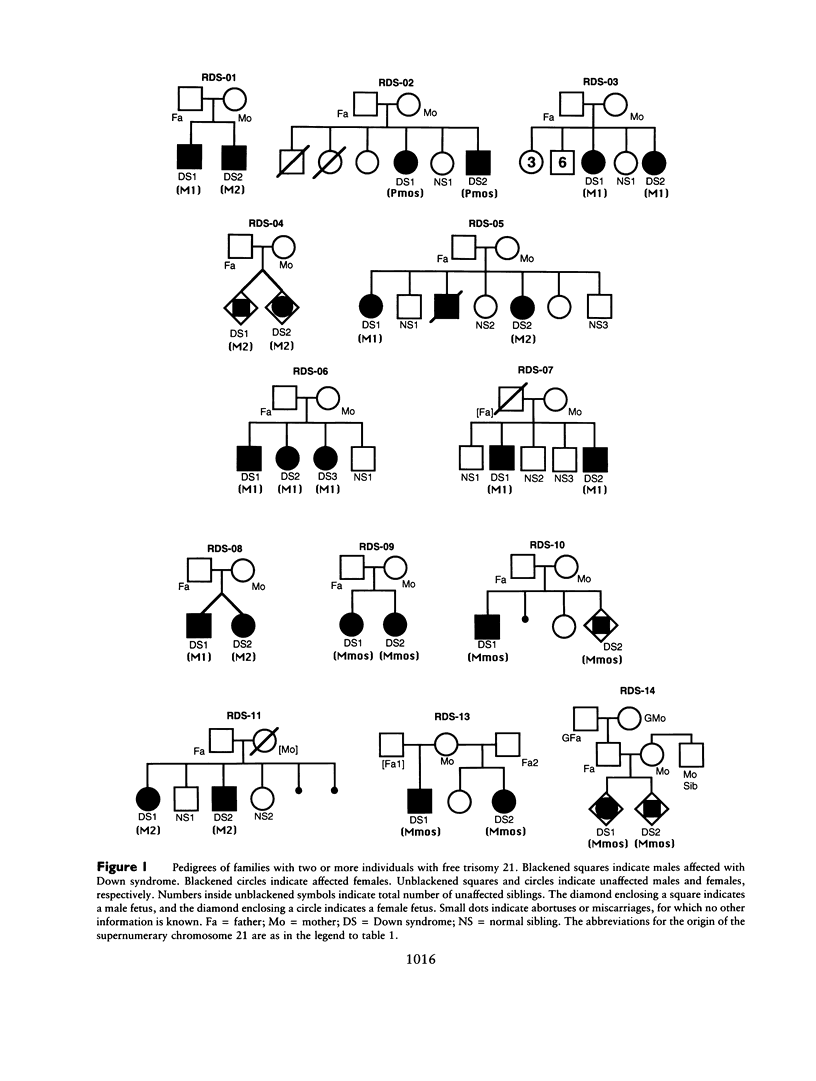
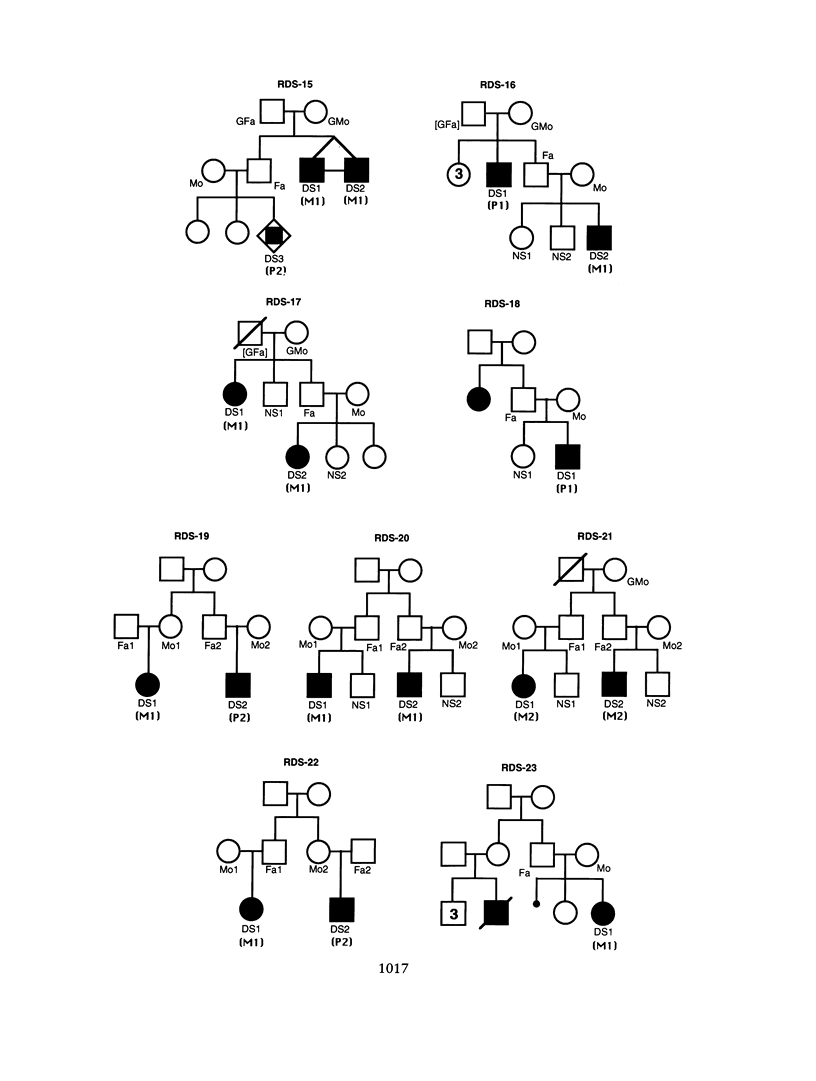
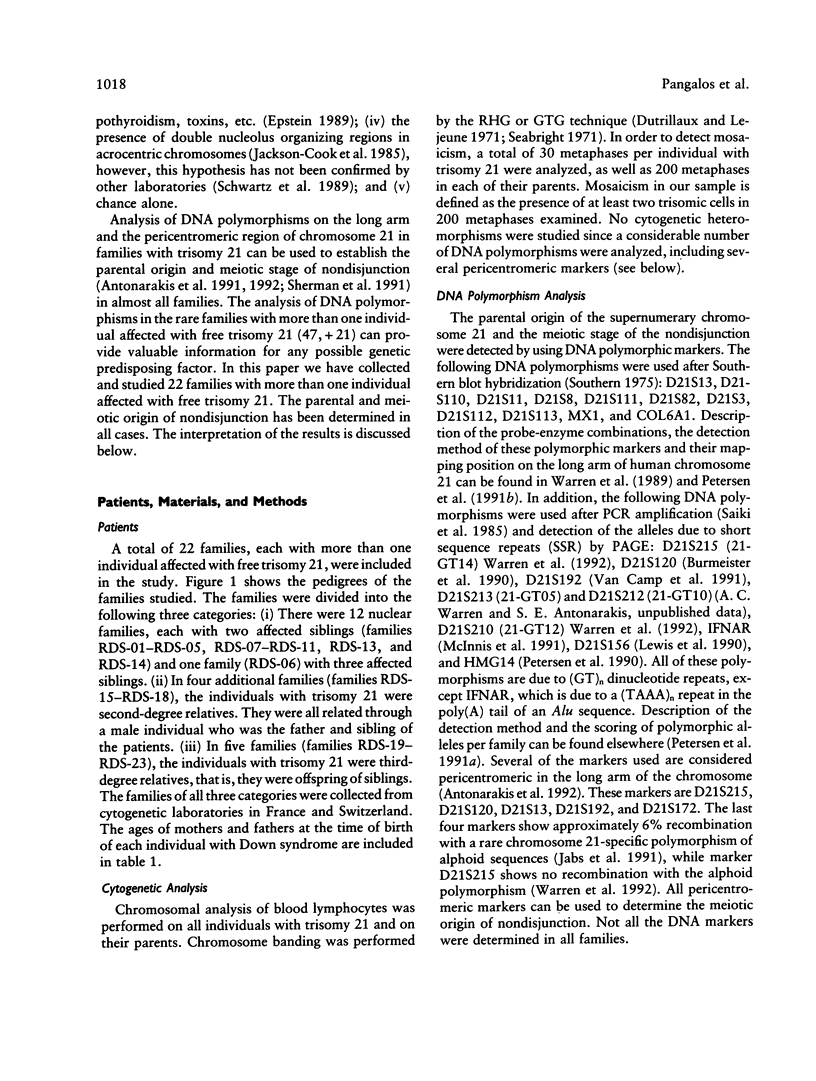
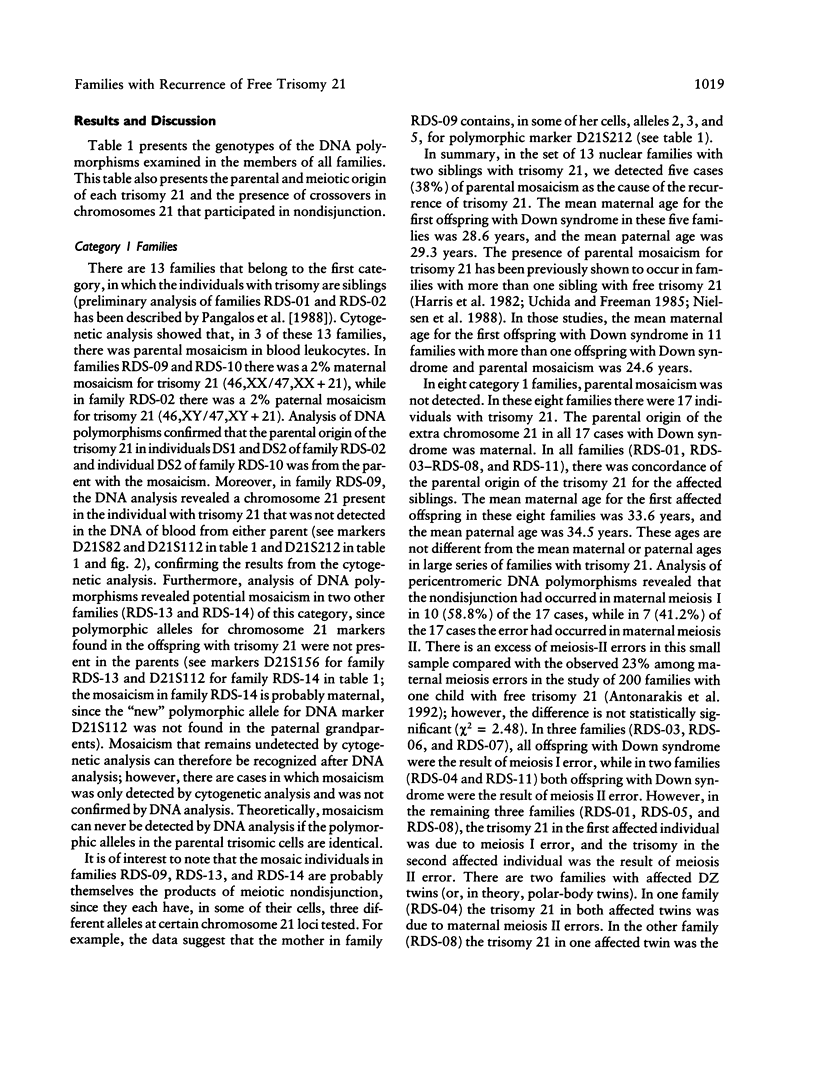
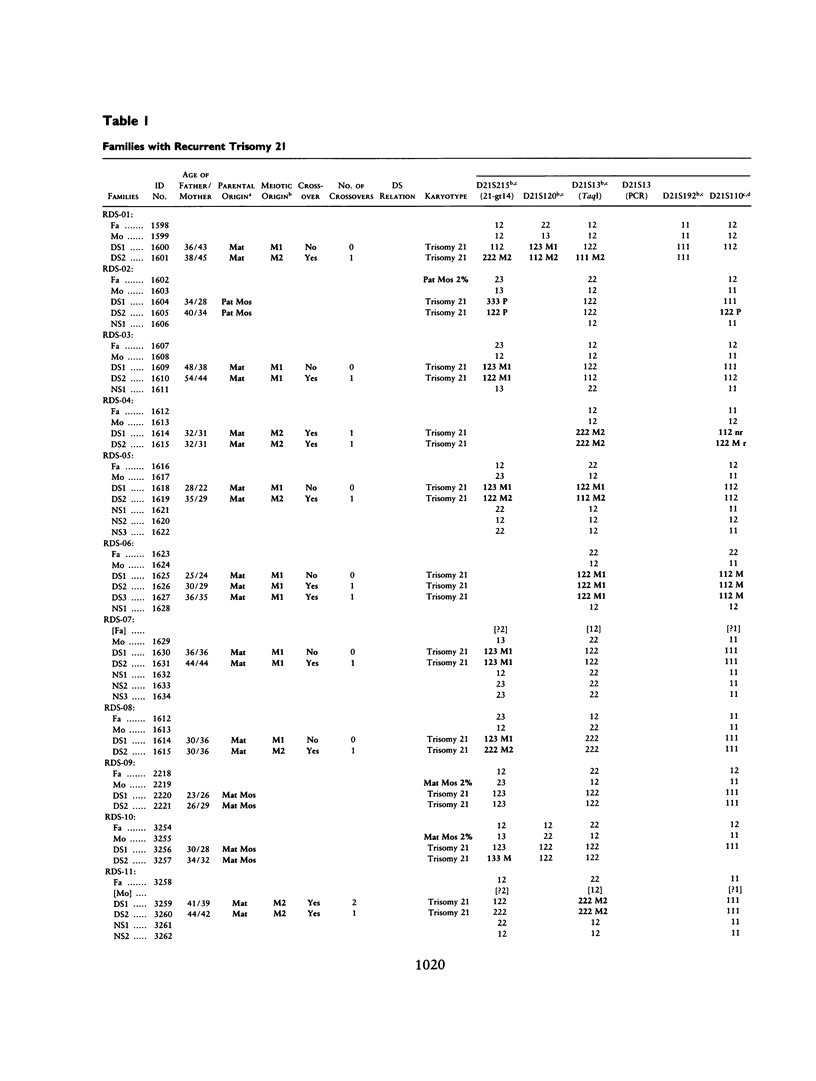
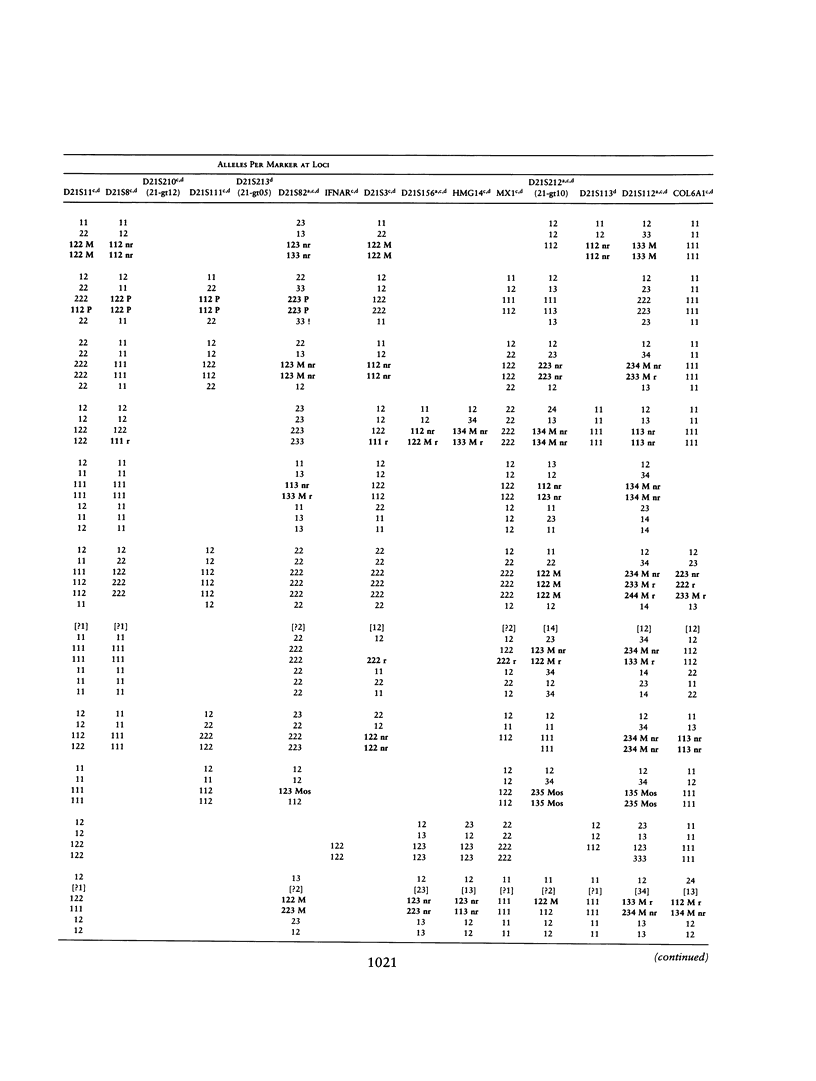

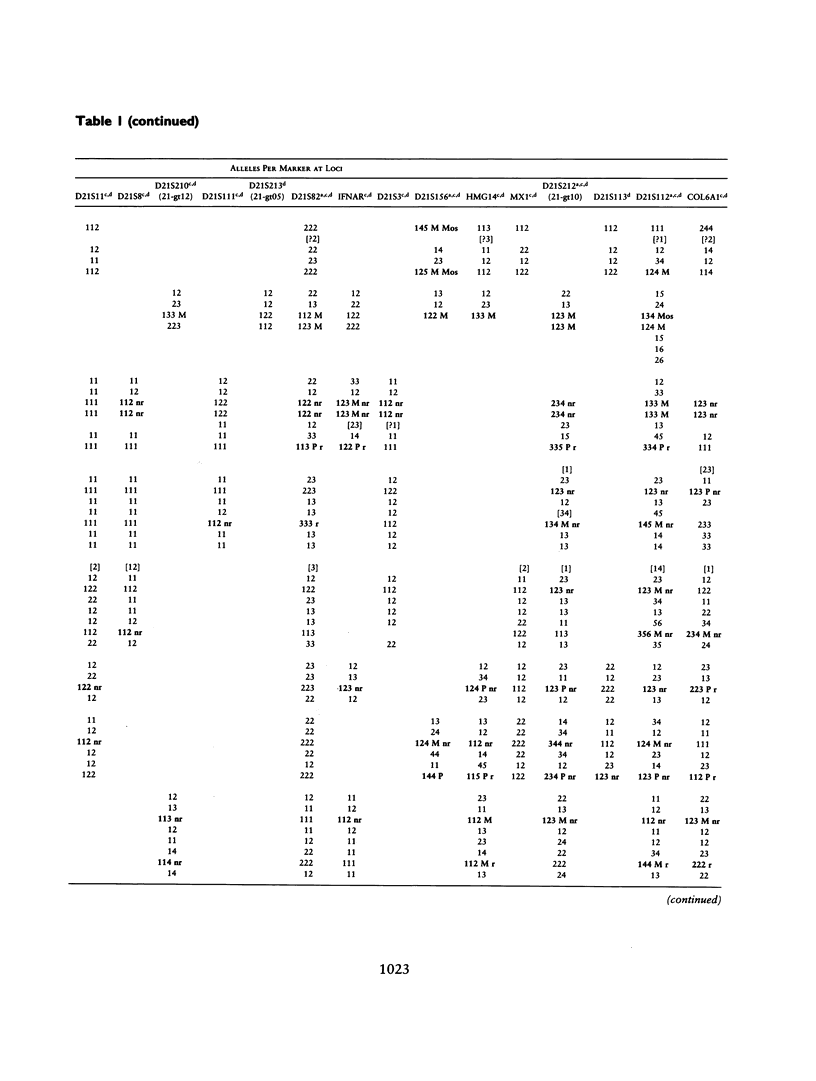
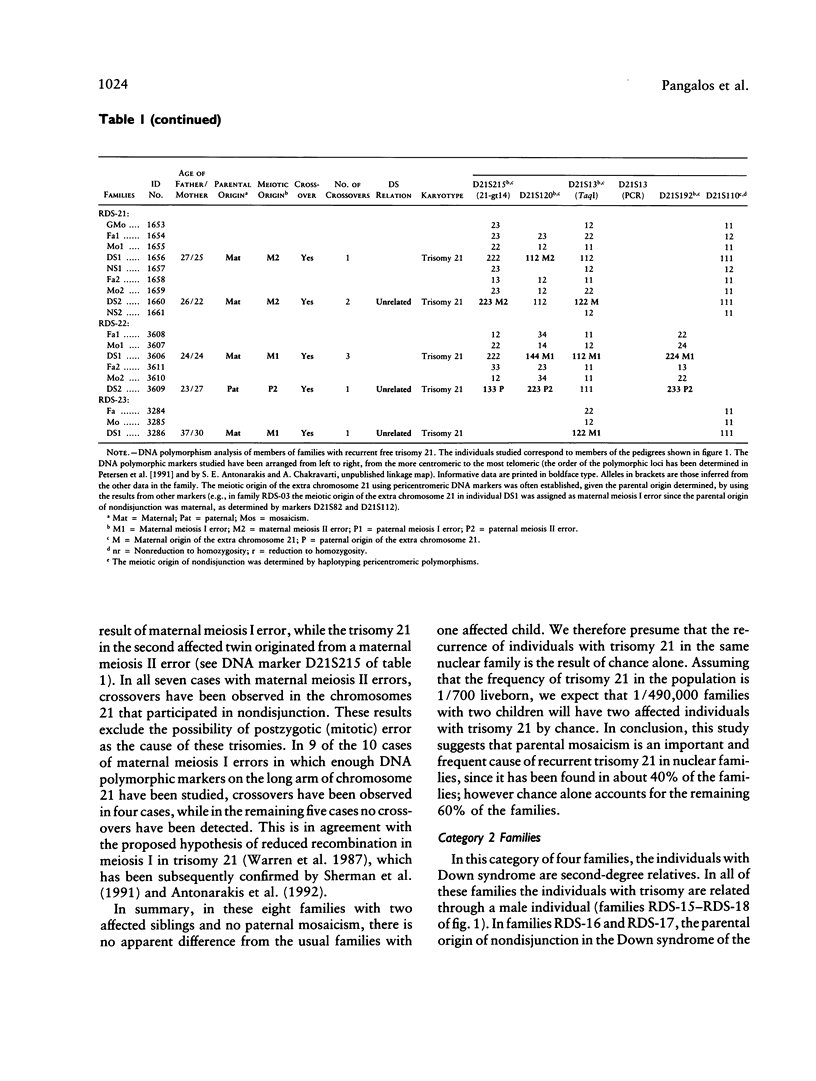
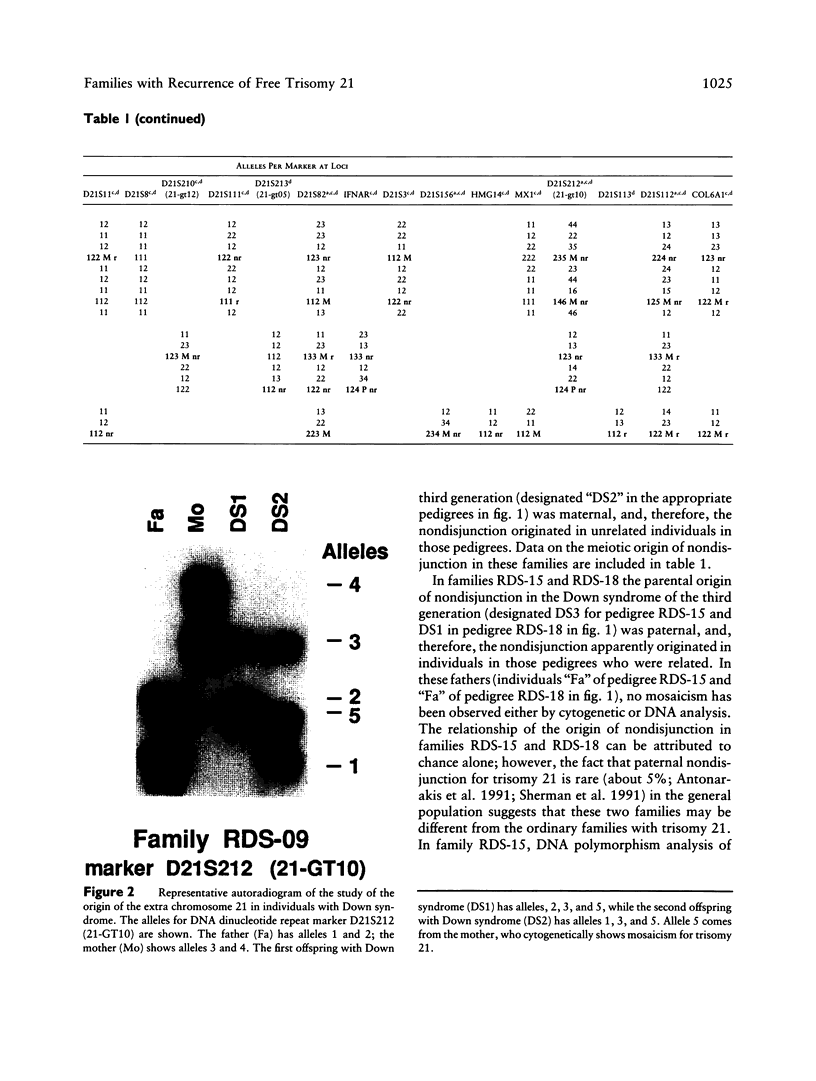
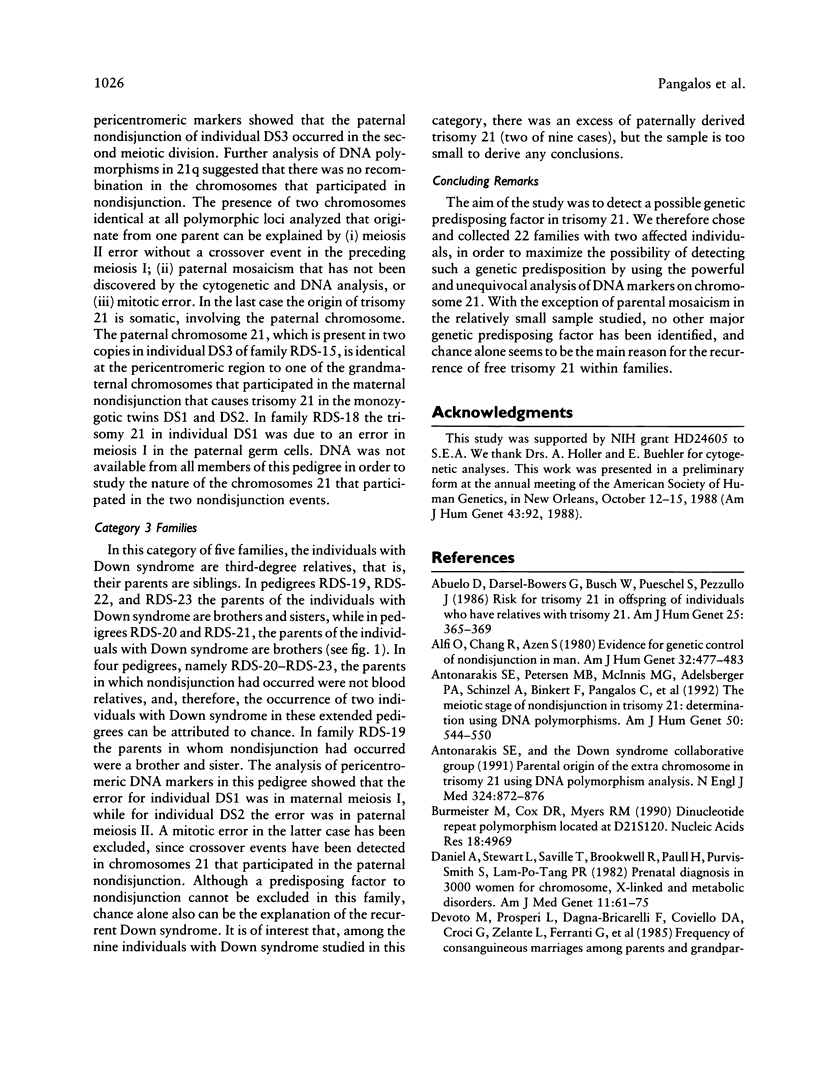
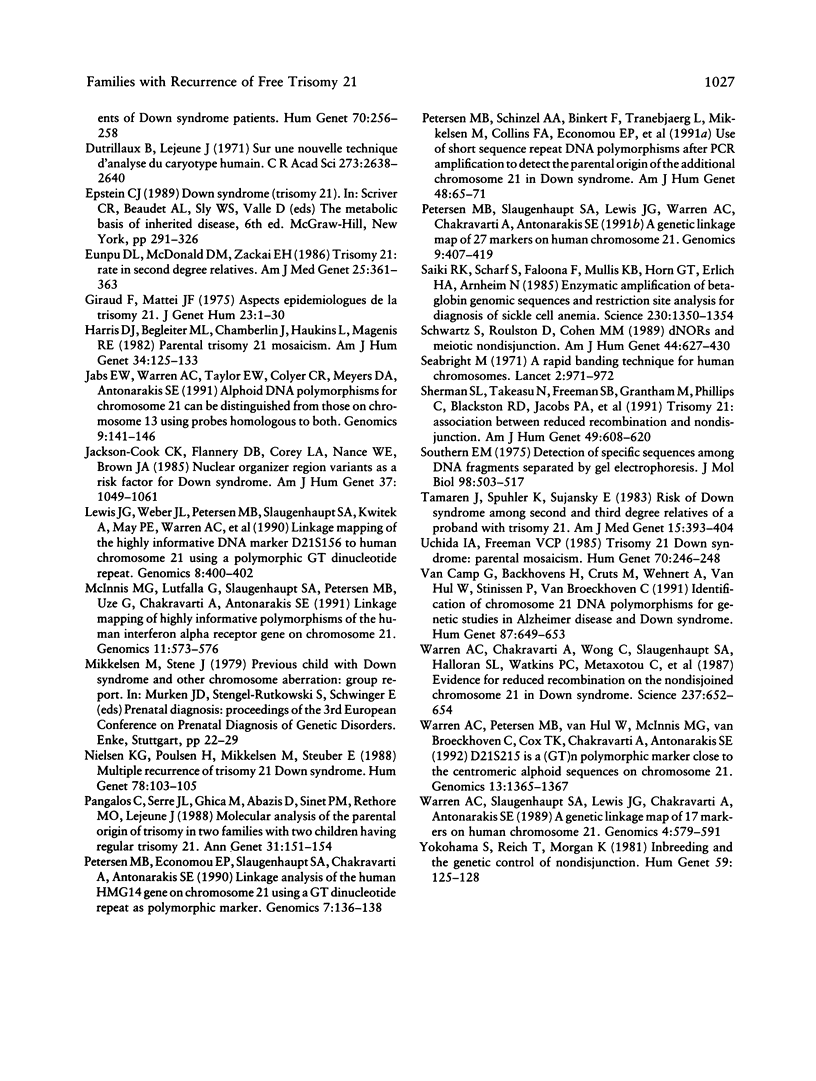
Images in this article
Selected References
These references are in PubMed. This may not be the complete list of references from this article.
- Abuelo D., Barsel-Bowers G., Busch W., Pueschel S., Pezzullo J. Risk for trisomy 21 in offspring of individuals who have relatives with trisomy 21. Am J Med Genet. 1986 Oct;25(2):365–367. doi: 10.1002/ajmg.1320250223. [DOI] [PubMed] [Google Scholar]
- Alfi O. S., Chang R., Azen S. P. Evidence for genetic control of nondisjunction in man. Am J Hum Genet. 1980 Jul;32(4):477–483. [PMC free article] [PubMed] [Google Scholar]
- Antonarakis S. E. Parental origin of the extra chromosome in trisomy 21 as indicated by analysis of DNA polymorphisms. Down Syndrome Collaborative Group. N Engl J Med. 1991 Mar 28;324(13):872–876. doi: 10.1056/NEJM199103283241302. [DOI] [PubMed] [Google Scholar]
- Antonarakis S. E., Petersen M. B., McInnis M. G., Adelsberger P. A., Schinzel A. A., Binkert F., Pangalos C., Raoul O., Slaugenhaupt S. A., Hafez M. The meiotic stage of nondisjunction in trisomy 21: determination by using DNA polymorphisms. Am J Hum Genet. 1992 Mar;50(3):544–550. [PMC free article] [PubMed] [Google Scholar]
- Burmelster M., Cox D. R., Myers R. M. Dinucleotide repeat polymorphism located at D21S120. Nucleic Acids Res. 1990 Aug 25;18(16):4969–4969. doi: 10.1093/nar/18.16.4969. [DOI] [PMC free article] [PubMed] [Google Scholar]
- Daniel A., Stewart L., Saville T., Brookwell R., Paull H., Purvis-Smith S., Lam-Po-Tang P. R. Prenatal diagnosis in 3,000 women for chromosome, X-linked, and metabolic disorders. Am J Med Genet. 1982 Jan;11(1):61–75. doi: 10.1002/ajmg.1320110109. [DOI] [PubMed] [Google Scholar]
- Devoto M., Prosperi L., Bricarelli F. D., Coviello D. A., Croci G., Zelante L., Ferranti G., Tenconi R., Stomeo C., Romeo G. Frequency of consanguineous marriages among parents and grandparents of Down patients. Hum Genet. 1985;70(3):256–258. doi: 10.1007/BF00273452. [DOI] [PubMed] [Google Scholar]
- Dutrillaux B., Lejeune J. Sur une nouvelle technique d'analyse du caryotype humain. C R Acad Sci Hebd Seances Acad Sci D. 1971 May 17;272(20):2638–2640. [PubMed] [Google Scholar]
- Eunpu D. L., McDonald D. M., Zackai E. H. Trisomy 21: rate in second-degree relatives. Am J Med Genet. 1986 Oct;25(2):361–363. doi: 10.1002/ajmg.1320250222. [DOI] [PubMed] [Google Scholar]
- Giraud F., Mattei J. F. Aspects epidémiologiques de la trisomie 21. J Genet Hum. 1975 Oct;23(Suppl):1–30. [PubMed] [Google Scholar]
- Harris D. J., Begleiter M. L., Chamberlin J., Hankins L., Magenis R. E. Parental trisomy 21 mosaicism. Am J Hum Genet. 1982 Jan;34(1):125–133. [PMC free article] [PubMed] [Google Scholar]
- Jabs E. W., Warren A. C., Taylor E. W., Colyer C. R., Meyers D. A., Antonarakis S. E. Alphoid DNA polymorphisms for chromosome 21 can be distinguished from those of chromosome 13 using probes homologous to both. Genomics. 1991 Jan;9(1):141–146. doi: 10.1016/0888-7543(91)90231-3. [DOI] [PubMed] [Google Scholar]
- Jackson-Cook C. K., Flannery D. B., Corey L. A., Nance W. E., Brown J. A. Nucleolar organizer region variants as a risk factor for Down syndrome. Am J Hum Genet. 1985 Nov;37(6):1049–1061. [PMC free article] [PubMed] [Google Scholar]
- Lewis J. G., Weber J. L., Petersen M. B., Slaugenhaupt S. A., Kwitek A., May P. E., Warren A. C., Chakravarti A., Antonarakis S. E. Linkage mapping of the highly informative DNA marker D21S156 to human chromosome 21 using a polymorphic GT dinucleotide repeat. Genomics. 1990 Oct;8(2):400–402. doi: 10.1016/0888-7543(90)90300-j. [DOI] [PubMed] [Google Scholar]
- McInnis M. G., Lutfalla G., Slaugenhaupt S., Petersen M. B., Uze G., Chakravarti A., Antonarakis S. E. Linkage mapping of highly informative DNA polymorphisms within the human interferon-alpha receptor gene on chromosome 21. Genomics. 1991 Nov;11(3):573–576. doi: 10.1016/0888-7543(91)90064-l. [DOI] [PubMed] [Google Scholar]
- Nielsen K. G., Poulsen H., Mikkelsen M., Steuber E. Multiple recurrence of trisomy 21 Down syndrome. Hum Genet. 1988 Jan;78(1):103–105. doi: 10.1007/BF00291249. [DOI] [PubMed] [Google Scholar]
- Pangalos C., Serre J. L., Ghica M., Abazis D., Sinet P. M., Rethoré M. O., Lejeune J. Analyse moléculaire de l'origine parentale de la trisomie dans deux fratries comportant deux enfants atteints de trisomie 21 libre. Ann Genet. 1988;31(3):151–154. [PubMed] [Google Scholar]
- Petersen M. B., Economou E. P., Slaugenhaupt S. A., Chakravarti A., Antonarakis S. E. Linkage analysis of the human HMG14 gene on chromosome 21 using a GT dinucleotide repeat as polymorphic marker. Genomics. 1990 May;7(1):136–138. doi: 10.1016/0888-7543(90)90531-x. [DOI] [PubMed] [Google Scholar]
- Petersen M. B., Schinzel A. A., Binkert F., Tranebjaerg L., Mikkelsen M., Collins F. A., Economou E. P., Antonarakis S. E. Use of short sequence repeat DNA polymorphisms after PCR amplification to detect the parental origin of the additional chromosome 21 in Down syndrome. Am J Hum Genet. 1991 Jan;48(1):65–71. [PMC free article] [PubMed] [Google Scholar]
- Petersen M. B., Slaugenhaupt S. A., Lewis J. G., Warren A. C., Chakravarti A., Antonarakis S. E. A genetic linkage map of 27 markers on human chromosome 21. Genomics. 1991 Mar;9(3):407–419. doi: 10.1016/0888-7543(91)90406-5. [DOI] [PubMed] [Google Scholar]
- Saiki R. K., Scharf S., Faloona F., Mullis K. B., Horn G. T., Erlich H. A., Arnheim N. Enzymatic amplification of beta-globin genomic sequences and restriction site analysis for diagnosis of sickle cell anemia. Science. 1985 Dec 20;230(4732):1350–1354. doi: 10.1126/science.2999980. [DOI] [PubMed] [Google Scholar]
- Schwartz S., Roulston D., Cohen M. M. dNORs and meiotic nondisjunction. Am J Hum Genet. 1989 May;44(5):627–630. [PMC free article] [PubMed] [Google Scholar]
- Seabright M. A rapid banding technique for human chromosomes. Lancet. 1971 Oct 30;2(7731):971–972. doi: 10.1016/s0140-6736(71)90287-x. [DOI] [PubMed] [Google Scholar]
- Sherman S. L., Takaesu N., Freeman S. B., Grantham M., Phillips C., Blackston R. D., Jacobs P. A., Cockwell A. E., Freeman V., Uchida I. Trisomy 21: association between reduced recombination and nondisjunction. Am J Hum Genet. 1991 Sep;49(3):608–620. [PMC free article] [PubMed] [Google Scholar]
- Southern E. M. Detection of specific sequences among DNA fragments separated by gel electrophoresis. J Mol Biol. 1975 Nov 5;98(3):503–517. doi: 10.1016/s0022-2836(75)80083-0. [DOI] [PubMed] [Google Scholar]
- Tamaren J., Spuhler K., Sujansky E. Risk of Down syndrome among second- and third-degree relatives of a proband with trisomy 21. Am J Med Genet. 1983 Jul;15(3):393–403. doi: 10.1002/ajmg.1320150305. [DOI] [PubMed] [Google Scholar]
- Uchida I. A., Freeman V. C. Trisomy 21 Down syndrome. Parental mosaicism. Hum Genet. 1985;70(3):246–248. doi: 10.1007/BF00273450. [DOI] [PubMed] [Google Scholar]
- Van Camp G., Backhovens H., Cruts M., Wehnert A., Van Hul W., Stinissen P., Van Broeckhoven C. Identification of chromosome 21 DNA polymorphisms for genetic studies in Alzheimer's disease and Down syndrome. Hum Genet. 1991 Oct;87(6):649–653. doi: 10.1007/BF00201718. [DOI] [PubMed] [Google Scholar]
- Warren A. C., Chakravarti A., Wong C., Slaugenhaupt S. A., Halloran S. L., Watkins P. C., Metaxotou C., Antonarakis S. E. Evidence for reduced recombination on the nondisjoined chromosomes 21 in Down syndrome. Science. 1987 Aug 7;237(4815):652–654. doi: 10.1126/science.2955519. [DOI] [PubMed] [Google Scholar]
- Warren A. C., Petersen M. B., Van Hul W., McInnis M. G., Van Broeckhoven C., Cox T. K., Chakravarti A., Antonarakis S. E. D21S215 is a (GT)n polymorphic marker close to centromeric alphoid sequences on chromosome 21. Genomics. 1992 Aug;13(4):1365–1367. doi: 10.1016/0888-7543(92)90072-z. [DOI] [PubMed] [Google Scholar]
- Warren A. C., Slaugenhaupt S. A., Lewis J. G., Chakravarti A., Antonarakis S. E. A genetic linkage map of 17 markers on human chromosome 21. Genomics. 1989 May;4(4):579–591. doi: 10.1016/0888-7543(89)90282-6. [DOI] [PubMed] [Google Scholar]
- Yokoyama S., Reich T., Morgan K. Inbreeding and the genetic control of nondisjunction. Hum Genet. 1981;59(2):125–128. doi: 10.1007/BF00293060. [DOI] [PubMed] [Google Scholar]



